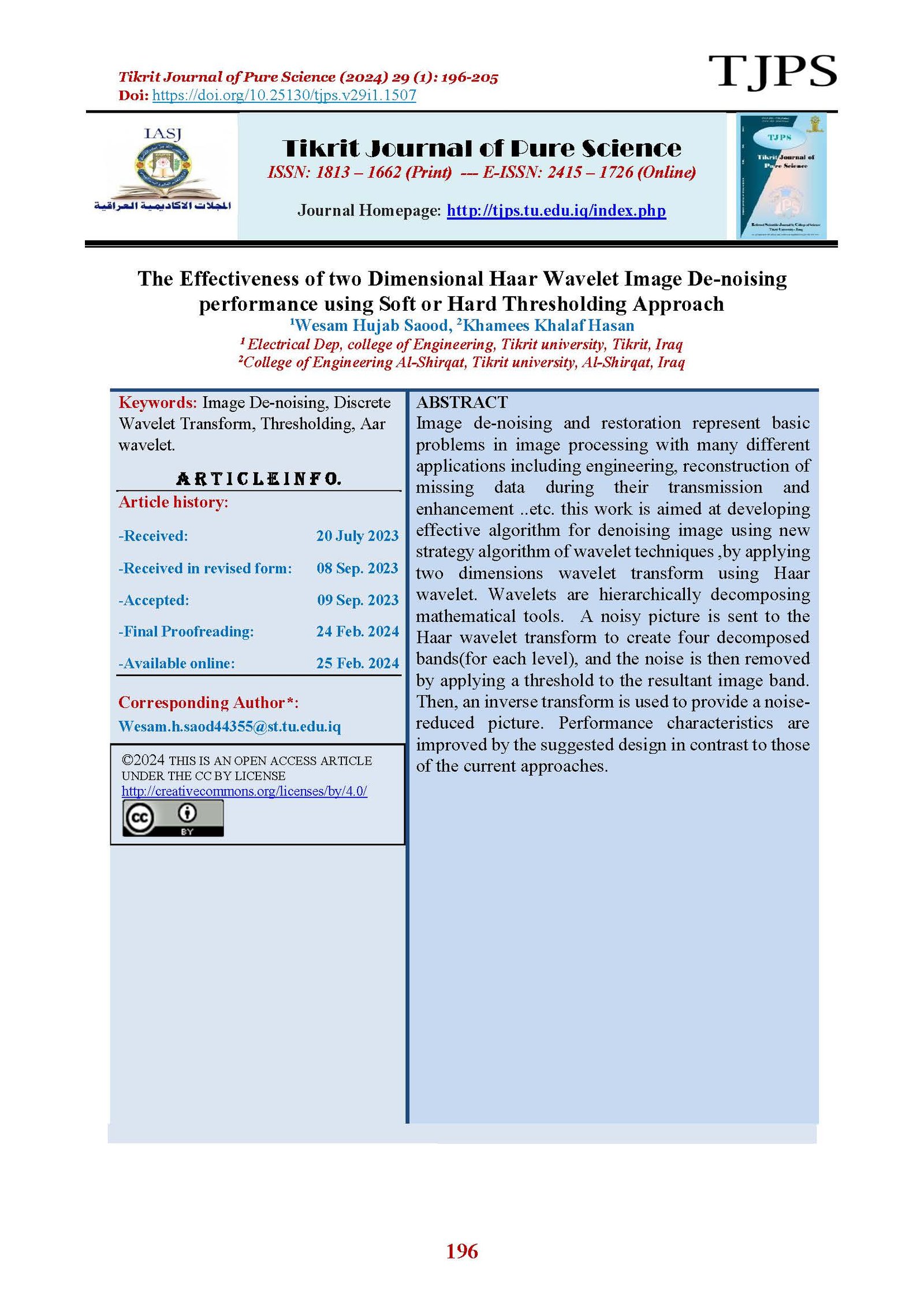The Effectiveness of two Dimensional Haar Wavelet Image De-noising performance using Soft or Hard Thresholding Approach
Main Article Content
Abstract
Image de-noising and restoration represent basic problems in image processing with many different applications including engineering, reconstruction of missing data during their transmission and enhancement ..etc. this work is aimed at developing effective algorithm for denoising image using new strategy algorithm of wavelet techniques ,by applying two dimensions wavelet transform using Haar wavelet. Wavelets are hierarchically decomposing mathematical tools. A noisy picture is sent to the Haar wavelet transform to create four decomposed bands(for each level), and the noise is then removed by applying a threshold to the resultant image band. Then, an inverse transform is used to provide a noise-reduced picture. Performance characteristics are improved by the suggested design in contrast to those of the current approaches.
Article Details

This work is licensed under a Creative Commons Attribution 4.0 International License.
Tikrit Journal of Pure Science is licensed under the Creative Commons Attribution 4.0 International License, which allows users to copy, create extracts, abstracts, and new works from the article, alter and revise the article, and make commercial use of the article (including reuse and/or resale of the article by commercial entities), provided the user gives appropriate credit (with a link to the formal publication through the relevant DOI), provides a link to the license, indicates if changes were made, and the licensor is not represented as endorsing the use made of the work. The authors hold the copyright for their published work on the Tikrit J. Pure Sci. website, while Tikrit J. Pure Sci. is responsible for appreciate citation of their work, which is released under CC-BY-4.0, enabling the unrestricted use, distribution, and reproduction of an article in any medium, provided that the original work is properly cited.
References
[1] Sakthidasan Alias Sankaran, K., and V. Nagarajan. "Noise removal through the exploration of subjective and apparent denoised patches using discrete wavelet transform." IETE Journal of Research 67.6 (2021): 843-852.
[2] Shahab, M.M., Hardan, S.M., and Hammoodi, A.S.: ‘A new Transmission and Reception Algorithms for Improving the Performance of SISO/MIMO-OFDM Wireless Communication System’, Tikrit Journal of Engineering Sciences, 2021, 28, (3), pp. 146-158 [3] Rajeswari, P., et al. "Denoising X-Ray Image Using Discrete Wavelet Transform and Thresholding." Futuristic Communication and Network Technologies: Select Proceedings of VICFCNT 2020. Springer Singapore, 2022. [4] Al-Aboosi, Yasin Yousif, and Radhi Sehen Issa. "Image denosing in underwater acoustic noise using discrete wavelet transform with different noise level estimation." arXiv preprint arXiv:1904.09257 (2019). [5] Ziyad, Shabana R., V. Radha, and Thavavel Vaiyapuri. "Noise removal in lung LDCT images by novel discrete wavelet-based denoising with adaptive thresholding technique." International Journal of E-Health and Medical Communications (IJEHMC) 12.5 (2021): 1-15. [6] Aravindan, T. E., and R. Seshasayanan. "Medical image DENOISING scheme using discrete wavelet transform and optimization with different noises." Concurrency and Computation: Practice and Experience 34.8 (2022): e5540. [7] Meshkat, Amin, and Rasoul Dehghani. "A new discrete wavelet transform appropriate for hardware implementation." International Journal of Circuit Theory and Applications 48.3 (2020): 369-384. [8] Abderrahim, Lanani, Meghriche Salama, and Djouambi Abdelbaki. "Novel design of a fractional wavelet and its application to image denoising." Bulletin of Electrical Engineering and Informatics 9.1 (2020): 129-140. [9] Liu, Yang, et al. "Invertible denoising network: A light solution for real noise removal." Proceedings of the IEEE/CVF conference on computer vision and pattern recognition. 2021. [10] Dan Waang , Liang Hong, Ce Zhang, Yajie Bai,Zhen Zhen Bi, Yier Lin and Mohammad Ayoub Khan Journal: Security and Communication Networks, 2022, volume 2022,page 1, Dol: 10.1155/2022/610072. [11] Tuba, Una, and Dejan Zivkovic. "Image Denoising by Discrete Wavelet Transform with Edge Preservation." 2021 13th International Conference on Electronics, Computers and Artificial Intelligence (ECAI). IEEE, 2021 [12] Dhas, M. Mohana, and N. Suresh Singh. "Image denoising using discrete wavelet transform and adaptive thresholding optimised with improved arithmetic optimisation algorithm and guided filter." International Journal of Computational Intelligence Studies 11.2 (2022): 131-156. [13] Aravindan, T. E., and R. Seshasayanan. "Medical image DENOISING scheme using discrete wavelet transform and optimization with different noises." Concurrency and Computation: Practice and Experience 34.8 (2022)
